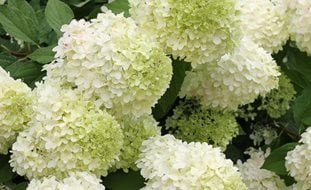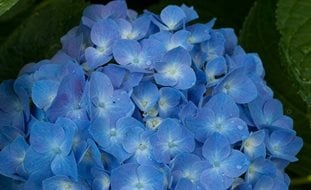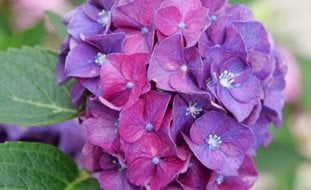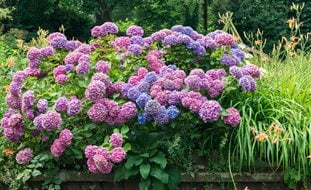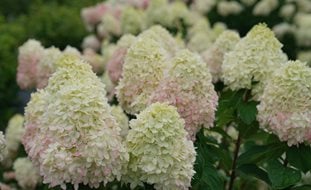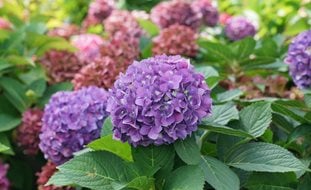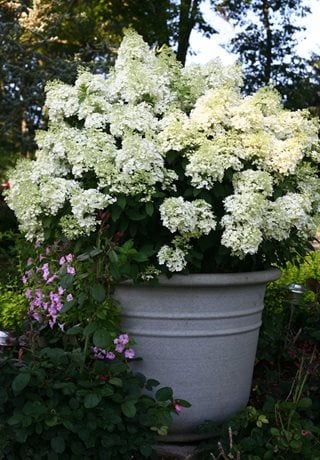How to Fertilize Hydrangeas
Keep your hydrangea plants healthy and producing blooms during the growing season by fertilizing properly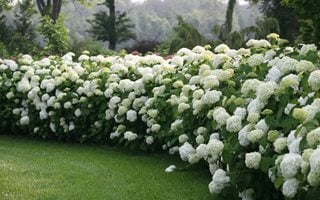
For healthy hydrangeas that really put on a show, it’s important to fertilize properly. Here, a row of floriferous white hydrangeas—Incrediball® smooth hydrangea (Hydrangea arborescens)—dazzle this garden with their many blooms. Photo by: Proven Winners.
Hydrangeas make a beautiful addition to any garden, and like most plants, fertilizing properly with the right plant food will help them become their best selves-healthy, floriferous, and vibrant. Read on to learn more about the best type of fertilizer to use, when to apply it, how to apply it, and more.
Best Fertilizer For Hydrangeas
Specialty fertilizers aren’t necessary to help your hydrangea plants thrive. One of the following types of fertilizers will work well for any hydrangea type:
- Organic, slow-release fertilizers for roses (such as a 15-10-10, or 10-5-5 formula) work well on hydrangeas, giving the plants the nutrients they need to increase the size and quantity of their blooms. If you’re looking for big blooms-and lots of them-this is the right fertilizer for your hydrangeas.
- Organic, slow-release, all-purpose, balanced fertilizer also works well for hydrangeas. While a balanced fertilizer such as one with a 10-10-10 ratio will give your plant what it needs for healthy growth, it won’t boost the size and number of blooms your plant will produce like a rose fertilizer will.
A common question from gardeners is whether you need to purchase different types of fertilizer if you have more than one type of hydrangea. Fortunately, the answer is no! You can use the same type of fertilizer for all your hydrangeas, no matter how many different types you have. However, if you have a goal of enhancing or changing the color of specific hydrangea blooms, then you may want to make some adjustments depending on the type.
But be careful, some types of fertilizer could do more harm than good. Natalie Carmolli of Proven Winners® ColorChoice® Flowering Shrubs cautions against using an acidic fertilizer:
"It’s a myth that hydrangeas require acidic soil, so we don’t recommend a fertilizer for acid-loving plants, without a pH test. If you do that, it can push the pH levels to a dangerous or unfavorable level for your hydrangea."
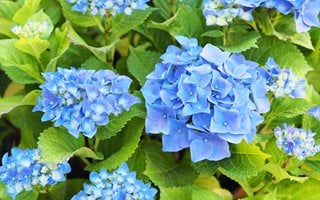
Some hydrangeas change color depending on the type of soil. The flower heads of ‘Nikko Blue’ bigleaf hydrangea (Hydrangea macrophylla) tend to look more blue in acidic soil and more pinkish in alkaline soil. Photo by: ANGHI / Shutterstock.com
Fertilizing To Change Bloom Color
The bloom colors of certain types of hydrangeas are impacted by the acidity of the soil, and many gardeners love experimenting with this. For example, did you know you can add aluminum sulfate to make blue flower sepals bluer, while adding garden lime makes sepals of pink flowers look pinker?
Learn more about changing hydrangea bloom colors.
An important note: If you do decide to experiment with intentionally changing your hydrangea’s bloom colors, we recommend doing it gradually. As you make changes, watch your plant carefully to make sure you don’t overdo it and harm your plant. It’s also important to get the timing right—for best results, you need to amend the soil long before your hydrangeas bloom—either in late fall or early spring.
When To Fertilize Hydrangeas & How Often
How often you fertilize and when you do it depends on whether your hydrangeas are planted in the ground or in pots.
- For hydrangeas planted in ground. For optimal growth, bloom production, and quality, fertilize three times:
- In early spring when plants are just leafing out
- In early May to boost their flower production for summer
- In late June/early July to help your plants finish the summer strong
- For hydrangeas you overwintered in containers, give them fertilizer in early spring and again in May. There’s no need to fertilize again during summer.
- For hydrangeas newly planted in containers, if your potting soil already contains a slow-release fertilizer, there’s no need to provide additional fertilizer in the first year. If your potting soil does not contain fertilizer, adding a slow-release formula at planting time and again in late spring to early summer will get them through the season.
Never apply hydrangea fertilizer too close to fall. Here Betty Montgomery, author of Hydrangeas: How to Grow, Cultivate & Enjoy explains why:
"You should never fertilize plants late in the growing season because you want them to go to sleep naturally. Late fertilization might produce new growth, and this new fall growth is tender. The new growth and buds might not have enough time to harden before a sudden frost strikes."
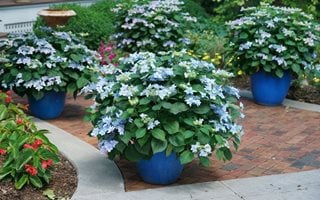
Fertilizing hydrangeas in containers is a bit different than fertilizing those planted directly in the ground. If your potting soil contains slow release fertilizer you can fertilize less often. Shown here: Tuff Stuff Ah-Ha® reblooming mountain hydrangea (Hydrangea serrata). Photo by: Proven Winners.
Fertilizer Application
Apply fertilizer around the drip line of the plant and avoid letting it touch the plant-direct exposure to some fertilizers can burn your plant’s leaves. Water your hydrangeas well before applying fertilizer, and then water the fertilizer into the soil thoroughly, especially if you’re using granular fertilizer instead of liquid fertilizer.
For detailed application information, follow the instructions on the fertilizer package.
Here is an application tip from Michael A. Dirr, author of Hydrangeas for American Gardens:
"My approach has always been cautionary; I use smaller quantities and apply them in split applications, for example, a late winter/early spring application, followed by an application after flowering.
If you are confused by the myriad of recommendations from experts, simply read the fertilizer rates recommended on the package and divide by two."
Troubleshooting
If your hydrangea plants aren’t doing well despite fertilizing using the right fertilizer for hydrangeas, check the pH and nutrient levels of your soil.
- If the nitrogen levels are too high, the stems and leaves will flourish, but the blooms and root system may suffer.
- High phosphorus levels prohibit the plant from taking in the required nutrients.
- High potassium can cause irregular leaf growth, rot, and more.
If you find that your hydrangeas are very leafy but not producing many blooms, that’s a sign that they may need a break from fertilizing. It’s okay to skip a year of fertilizing and instead put compost or organic matter around your hydrangeas. This will allow your soil to bounce back. Test the pH levels to ensure nutrients are available in youru soil. See more about why your hydrangea isn't blooming.
The first four minutes of this video by Garden Answer covers the basics of fertilizing hydrangeas.
